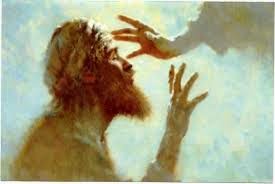Spring is nearly one week old, but we’re not convinced are we? Temperatures are still hovering in the winter range and although we’ve appeared to dodge a “nor’easter,” today’s forecast calls for light snow. Yet, somehow the world around us knows what we don’t see, or perhaps refuse to see. There is more light as daylight lengthens; the lawn, despite the cold, shows some signs of green in response to the light. The birds have once again begun to sing; they know the light, and ignore the cold. Yet I, layered in warm clothing, watch out my window as the woodpecker drills holes in my Atlas cedar, and mines the rising sap. He knows what the light reveals. And what about the crocus struggling under remnants of not-yet-melted snow, making its presence felt in response to the light. It knows despite its icy blanket. Yet I question and wonder, can it really be spring?
In our Gospel (John 9:1-41), John presents Jesus as
the light in the darkness, calling forth life. And as witnessed by the world
outside my window, all life springs from the light as it lengthens in the world.
In this ambivalent month: warm one day, cold another, the light warms the soil
and calls the seeds to come to life. March knows instinctively what we find
hard to believe.
We can deny the season but we cannot deny the
light’s return. Seeing is believing…right? In our Gospel, Jesus restores a
blind man’s sight. Yet, the Pharisees are unwilling to accept what they see, ask
a barrage of questions: can he really see; is this the same man; ask his
parents if he was born blind; how did Jesus open his eyes. What more can the
man say; he was blind, Jesus gave him sight and now he can see. Still not
wanting to believe what they have seen and heard, the Pharisees drive the man
away…out of their sight.
Perhaps the unwillingness to believe in the obvious
may seem an exaggeration by John to make a point, but is it? Sometimes, despite
what we see and hear, we find it difficult to let go of what we think we know.
The inability to let go and put our egos aside is part of our human condition.
It can be argued that believing and understanding are the Provence of the
intellect, while knowing is an intuitive part of our being. We know air, we don’t believe in it. So, what does it take
for his light to penetrate and our hearts to open and to just let go without question? Isn’t it
curious how all of nature knows the light and responds without question, and we
can’t let go of winter and open our eyes to the light?
And the river bank talks of the waters of March
It's the promise of life, it's the joy in your heart
It's the promise of life, it's the joy in your heart
And the river bank talks of the waters of March
It's the end of all strain, it's the joy in your heart
http://www.youtube.com/watch?v=6MNknFy2gdQ
It's the end of all strain, it's the joy in your heart



